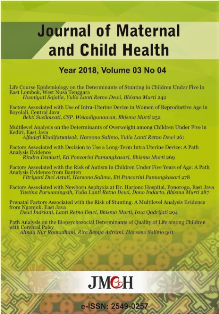Factors Associated with Use of Intra-Uterine Device in Women of Reproductive Age in Boyolali, Central Java
Abstract
Background: Family planning is a key strategy for reduction of maternal mortality. Family planning aims to control birth in order to control population growth. Long-acting reversible contraceptives (LARCs), which include intra-uterine device (IUD), are the most effective methods of birth control. Studies into factors affecting the uptake of IUD was lacking in Indonesia. This study aimed to investigate factors associated with use of IUD in women of reproductive age in Boyolali, Central Java, using multilevel analysis model and Theory of Planned Behavior.
Subjects and Method: This was a case control study carried out in 25 posyandus (integrated community health posts) in Boyolali, Central Java, from April to June 2018. A sample of 200 women was selected by simple random sampling. The dependent variable was IUD use. The independent variables were education, family income, intention, attitude, subjective norm, perceived behaviour control, and husband support. The data were collected by questionnaire and analyzed by a multilevel logistic regression on Stata 13.
Results: IUD use among women reproductive age increased with higher maternal education (b= 4.06; 95% CI= 0.68 to 7.44; p=0.019), higher family income (b= 3.90; 95% CI= 1.67to 7.64; p=0.041), positive attitude (b= 4.54; 95% CI= 0.52 to 8.55; p=0.027), positive subjective norm (b= 3.06; 95% CI= 0.01to 6.10; p= 0.049), strong perceived behaviour control (b= 3.40; 95% CI= -0.04to 6.85; p=0.053), strong intention (b= 3.18; 95% CI= -0.06to 6.41; p= 0.054), and strong husband support (b= 4.28; 95% CI= 0.01to 7.44; p= 0.050). Posyandu had a contextual effect on IUD use with ICC= 32.10%.
Conclusion: IUD use among women reproductive age increases with higher maternal education, higher family income, positive attitude, positive subjective norm, strong perceived behaviour control, strong intention, and strong husband support. Posyandu has sizeable contextual effect on IUD use.
Keywords: intra-uterine device, utilization, determinants, multilevel analysis
Correspondence:
References
Alemayehu M, Belachew B, Tilahun T (2012). Factors Associated with Utilization of Long Acting and Permanent Contraceptive Methods among Married Women of Reproductive Age in Mekelle Town, Tigray Region, North Ethiopia. BMC Pregnancy and Childbirth, 12: 6.
ArmaF, Tanjung A, Maisa ZI, Arifin M, Novera M (2014). Faktor-Faktor yang Berhubungan dengan Pemilihan Kontrasepsi IUD Bagi Akseptor KB Di Wilayah Kerja Puskesmas Sungai Lansek Tahun 2014. Jurnal Kesehatan.
Badan Pusat Statistik (2016). Statistik Indonesia 2016. Jakarta: BPS.
BKKBN (2017). Rencana Strategis badan Kependudukan dan Keluarga Berencana Nasional Tahun 2015-2019. Jakarta.
Budiarti I, Nuryani DD, Hidayat R (2017). Determinan Penggunaan Metode Kontrasepsi Jangka Panjang (MKJP) Pada Akseptor KB. Jurnal Kesehatan, 8 (2): 220-224.
Dehlendorf C, Levy K, Kelley A, Grumbach K, Steinauer J (2013). Women's Preferences for Contraceptive Counseling and Decision Making.Contraception, 88:250
Ela S, Hall KS, Melissa K. ZochowskiMBA. (2016). I Don
Frost JJ, Lindberg LD, Finer LB (2012). Young Adults
Glasier A, Gebbie A (2012). Metode Barier dalam Keluarga Berencana dan Kesehatan Reproduksi. Jakarta: EGC.
Gomez AM, Fuentes L, Allina A. (2014). Women or LARC first?. Reproductive autonomy and the promotion of longacting reversible contraceptive methods. Perspect Sex Reprod Health, 46(3):171
Hall KS, Patton E, Crissman H, Zochowski M, Dalton VK. (2015). A Population Based Study of U.S. Women
Hall KS, Moreau C, Trussell J. (2012). Continuing social disparities despite upward trends in sexual and reproductive health service use among young women in the United States. Contraception, 86: 681
Higgins JA (2014). Celebration meets caution: LARC's boons, potential busts, and the benefits of a reproductive justice approach. Contraception, 89(4): 237
Hong R, Montana L, Mishra V (2015). Family Planning Services Quality as a Determinant of Use of IUD in Egypt. BMC Health Services Research, 6:79.
Joeliatin, Murti B, Suryani N (2016). Theory of Planned Behavior on the Determinants of Participation in the Long-Term Contraceptive Method Among Women of Reproductive Age, in Nganjuk, East Java.Journal of Health Promotion and Behavior, 1(3): 171-179 https://doi.org/10.26911/thejhpb.2016.01.03.04.
Kemenkes RI (2016). Situasi dan Analisis Keluarga Berencana. Jakarta: Pusat data dan Informasi Kementerian Kesehatan Republik Indonesia.
Komey L (2016). Knowledge, Attitude and Perceptions of Contraceptive Use Among Second Cycle Institutions in the Adentan Municipality. University of Ghana.
Liando, Runkat M, Manueke I (2013). Faktor-Faktor yang Berhubungan dengan Penggunaan Alat Kontrasepsi Dalam Rahim di Kelurahan Pangolombian Kota TomohonTahun 2013. JurnalIlmiahBidan, 2(1).
Tyler CP, et al. (2012). Health Care Provider Attitudes and Practices Related to Intrauterine Devices for Nulliparous Women. Obstet Gynecol. 119(4): 762
Salisbury P, Hall L, Kulkus S, Paw MK, Tun NW, Min AM, Chotivanich K et al. (2016). Family Planning Knowledge, Attitudes and Practices in Refugee and Migrant Pregnant and Post Partum Women on the Thailand Myanmar Border
Yustiani (2013). Hubungan Tingkat Pendidikan Ibu Rumah Tangga dengan Persepsi Penggunaan Alat Kontrasepsi di Kelurahan Tondo Kecamatan Mantikulore Kota Palu.










